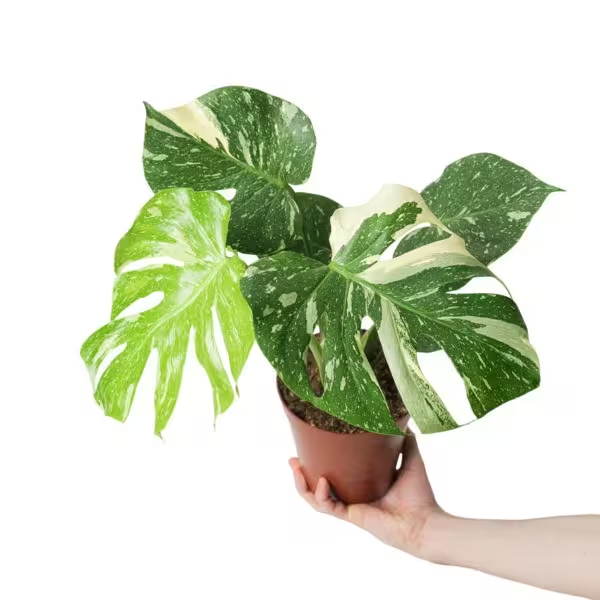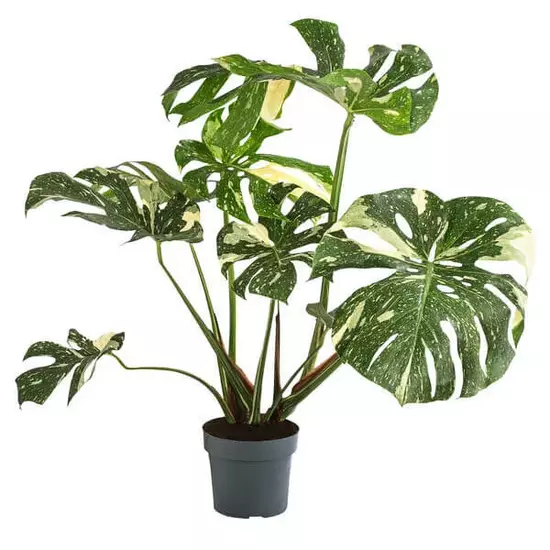Selling Size : Please Choose | 2.5″-4″ Pot Included | Secure Packing
The Monstera Thai Constellation is a highly sought-after variegated plant, prized for its unique, creamy white and pale green speckled or marbled leaves that resemble a starry night sky. It’s a true showstopper, but it does require specific care to thrive, especially in a climate like India’s, which can have varying humidity and temperatures.

Here’s a comprehensive guide to caring for your Monstera Thai Constellation:
1. Light:
- Bright, indirect light is paramount. This is the most crucial factor for maintaining its stunning variegation and encouraging healthy growth. The white parts of the leaves lack chlorophyll, so they photosynthesize less, meaning the green parts need ample light to compensate.
- Avoid direct, harsh sunlight, especially the intense afternoon sun in India. It will scorch the delicate white parts of the leaves, causing brown, crispy spots.
- Ideal placement: An east-facing window is perfect, as it provides gentle morning sun. A few feet away from a south or west-facing window, with sheer curtains or other filtration, can also work.
- Too little light will lead to slower growth, smaller leaves, and potentially less pronounced variegation or even a reversion to more green leaves.
2. Watering:
- Water thoroughly when the top 2-3 inches (5-7.5 cm) of soil are dry to the touch. This usually means once a week to every 10 days, but it can vary significantly based on your local climate, pot size, and soil mix. In India’s warm months, you might need to water more frequently.
- Do not let the plant sit in soggy soil. This is the number one killer of Thai Constellations (and many other Aroids). They are highly prone to root rot.
- Ensure excellent drainage. Always use a pot with drainage holes. If using a decorative outer pot, make sure the inner nursery pot can be lifted out to drain completely.
- It’s better to slightly underwater than to overwater. If you’re unsure, wait an extra day.
- Signs of improper watering:
- Yellowing leaves (especially lower ones): Often a sign of overwatering.
- Crispy brown edges or spots on white areas: Can indicate underwatering or low humidity.
- Drooping leaves: Can be from either overwatering (root rot) or underwatering. Check soil moisture to determine the cause.
3. Humidity:
- Monstera Thai Constellations are tropical plants and thrive in high humidity (ideally 60-80% or higher). This is particularly important for preventing browning on the delicate variegated parts of the leaves.
- Given India’s climate, especially in humid regions, natural humidity might be sufficient during monsoon, but in drier seasons or regions, you’ll need to supplement.
- Ways to increase humidity:
- Use a humidifier: This is the most effective and consistent method.
- Pebble tray: Place the pot on a tray filled with pebbles and water, ensuring the pot does not sit directly in the water.
- Misting: While temporary, regular misting (daily or multiple times a day) can help, especially for new leaves.
- Group plants together: Plants release moisture, creating a microclimate.
4. Temperature:
- Maintain warm, consistent temperatures between and ( and ).
- Avoid temperatures below (), cold drafts, or sudden temperature fluctuations, which can stress the plant and lead to browning or stunted growth. Keep it away from AC vents.

5. Soil and Potting:
- A chunky, airy, and extremely well-draining potting mix is essential for Monstera Thai Constellations. This mimics their epiphytic nature, where they grow on other plants rather than in dense soil.
- A good “aroid mix” typically includes:
- Orchid bark (for excellent drainage and aeration)
- Coco coir or peat moss (for moisture retention)
- Perlite or pumice (for drainage and aeration)
- Vermicompost or compost (for slow-release nutrients)
- Some growers also add horticultural charcoal.
- Avoid dense, heavy potting mixes that retain too much moisture.
- Repotting: Repot when the plant becomes root-bound, usually every 1-2 years. Choose a pot only one size larger than the current one to prevent excess soil from holding too much moisture.
6. Fertilizer:
- During the active growing season (spring and summer), fertilize every 2-4 weeks with a balanced liquid fertilizer diluted to half or quarter strength.
- Do not over-fertilize, as this can lead to salt buildup and burn the roots or variegated leaves.
- Reduce or stop fertilizing during the fall and winter months when growth slows down.
- Always water the plant before fertilizing to prevent root burn.
7. Support:
- Monstera Thai Constellations are climbing vines and will benefit greatly from a moss pole, coco coir pole, or other sturdy support to climb on.
- Providing support encourages the plant to produce larger, more mature leaves with fenestrations (splits and holes). Gently tie the stems to the support as the plant grows.
8. Pruning:
- Prune to maintain shape, size, or to remove yellowing/damaged leaves. Use clean, sharp shears.
- You can prune off leggy growth to encourage a bushier plant.
- Pruning is best done during the active growing season.
9. Pests and Diseases:
- Keep an eye out for common houseplant pests like spider mites, mealybugs, thrips, and scale insects. Inspect your plant regularly, especially the undersides of leaves.
- Treat any infestations promptly with insecticidal soap or neem oil.
- Root rot is the most common disease, caused by overwatering. Ensure proper drainage and watering practices.

10.Monstera Thai Constellation Toxicity:
- Like other Monsteras, the Thai Constellation contains calcium oxalate crystals and is toxic if ingested by pets or humans, causing irritation. Keep it out of reach.
Caring for a Monstera Thai Constellation can be incredibly rewarding, but it does require attention to detail, especially regarding light, watering, and humidity. By providing these optimal conditions, you can enjoy the stunning beauty of this highly prized plant for years to come.
| Size |
|---|
Only logged in customers who have purchased this product may leave a review.












 If you need any assistance, I'm always here. Have you found what you were looking for?
If you need any assistance, I'm always here. Have you found what you were looking for?
Reviews
There are no reviews yet.